
Hayman Goes Latin
It is said that Richard Hayman’s virtuoso harmonica performances have brought about a renaissance of that particular instrument’s popularity. Ever since he entered the professional ranks, with the noted Borrah Minevitch Harmonica Rascals, he has become known as a musical experimenter, not only as a performer, but also as a conductor, composer and arranger. His success in these endeavors is affirmed by his numerous hits on MERCURY RECORDS, and by the constant demand for his radio, TV and personal appearances. Richard Hayman’s affinity for the Latin idiom has enabled him to assimilate the sensuous color and rhythms of Spain and our Hispanic neighbors south of the border into a rich, invigorating and exciting orchestral presentation. Each of the captivating dances heard here transmits an impulse of immediacy that places the listener at the scene… whether it be the exotic reaches of an ancient Spanish city and its environs, or a fantasy landscape of flowered beauty, fringed by moon-drenched beaches and washed by warm shimmering waters. This scenic splendor is readily apparent in Miramar… “A Look at the Sea”… in which strings soar to a peak of pulsating perfection and a vivacious harmonica sparks the bewitching beguine. Moving inland we find Flor Del Tropico… “The Flower of the Tropics” from the island where the beguine was born, enchanting Martinique. Amid the floral treasures, the enticing rhythms of this native Creole dance are blended by harmonica solos, maracas and orchestral complement. The West Indian flavoring is furthered by Give Me This, Give Me That, a bright calypso rendition that expounds traditional island folklore with a rollicking steel band atmosphere. Wasted Years is a wistful love song in the rhythms of a Caribbean rumba, in which the Hayman harmonica returns for some melodic interchanges with rhythm, reeds and strings. Another romantic setting, high in the mountains of your dreams, introduces a tango. This Moonlit Mountain is musically illuminated by Al Caiola’s Spanish-flavored guitar embellishments. The tempestuous tango theme also extends to two intriguing individuals. One is the dashing young man around a Latin town… the Caballero while the other is his sensuous partner… Lili. The bolero, the national dance of Spain, takes the spotlight, next. Invented around 1780, this dance form has come to have two faces… fiery and exciting or projecting a mood of insinuating simplicity, such as Bolero Azul, which depicts the delicate blue waters playing on the sandy beaches of San Sebastian, the Costa Brava and other coastlines. In the bravura bolero vein, the Hayman Orchestra enchants with the imaginative Don’t Forget and the exhilarating Carefree. The festive rhythms of the paso doble, a dance which originated in Spain but swept all Spanish-America because of its association with bullfighting, also falls under the Richard Hayman spell. Amid a spurt of brass and flickering strings, the orchestra presents The Gay Matador and then goes on to mold the fusion of the captivating melodic effects of two Latin nations… Spain and Mexico… in a romantic coalition called Spaixico, which seems to sum up the spirited verve of ‘Hayman Goes Latin.’
